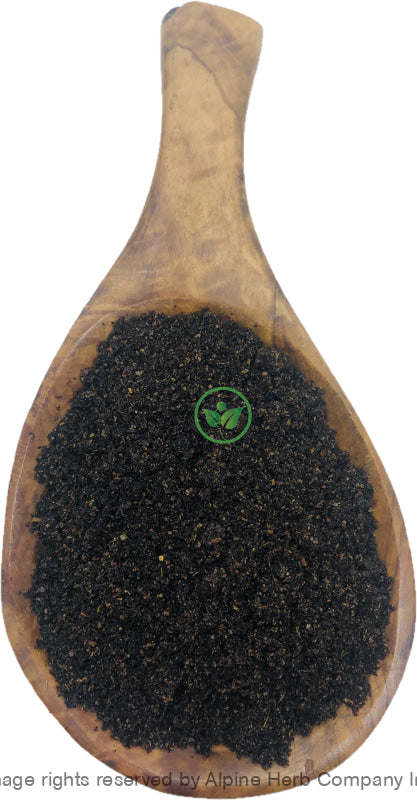Elderberry Powder Alpine Herb Company Inc.
$ 12,99 $ 7,79
Note: Due to the nature of the product, Elderberry Powder is NOT a fine powder.
Botanical Name: Sambucus nigra
Common Name:
- English: Black Elderberry,
- Also, known as: Black Elder, Holunder, Sureau, Sauco, Sambreo, European elder, Boretree, Pip tree, Devil’s wood, Sureau, Schwarzer Holunder, Sambuco, Sabugueiro, Saúco, Sabuco, Khamaan Kabir, Black Elder, Boor Tree, Bountry, Elder, Common Elder. Elder Berry, Elderberries, Elderberry Fruit, Ellanwood, Ellhorn, European Alder, European Black Elder, European Black Elderberry, European Elderberry, European Elder Fruit, European Elderberry, Fruit de Sureau, Grand Sureau, Hautbois, Holunderbeeren, Sabugeuiro-negro, Sambequier, Sambu, Sambuc, Sambuci Sambucus,
Origin: Bulgaria
Harvested: Wild or Cultivated
Parts Used: Berries
General Information:
Sambucus nigra, is a large shrub or small tree, to 20 feet, with coarse, gray, furrowed bark. Pinnate, compound leaves arranged in opposite pairs. White, star-shaped flowers grows in clusters, 4 to10 inches wide, in late spring to midsummer. Compound pinnate leaves up to 8” long are dark green. Each leaf contains 2 to 8 serrate, ovate to elliptic leaflets up to 5” long. Leaves have an unpleasant aroma when cut or crushed. Tiny white flowers in large flattened umbel-like cymes up to 10” across bloom in June-July. Flowers have a musky fragrance. Flowers give way to clusters of glossy black elderberry fruits, each to 3/8” across in late summer. It is particularly noted for its aromatic late spring flowers and its edible fruits (elderberries). The fruits (elderberries) are three-seeded drupes (edible only when ripe and preferably cooked). Drooping berries produced in the fall.
Grows in moist woodlands, thickets, and fencerows. Elder is tolerant of pruning and can be cut to the ground in late winter to help keep the shrub healthy.
Flowers and berries are wild-harvested or collected from commercial plantations. The inflorescences are picked on a dry, sunny day (to preserve the pollen) and are carefully placed upside down to dry so that the flowers can be collected. The fruits are picked when black and fully ripe.
How to use:
Powdered Herb:
There are different ways to use powdered herb.
Food Preparation: You can add powdered herbs to any super food, herbal smoothie, sauces, spreads and even cookies. Also for children, you can mix powdered herbs with honey or glycerin to make a paste. The thicker the paste, the more potent and herbal in taste. The sweet taste of honey and glycerin will help the medicine go down. This method is also known as “Electuaries”.
Capsules: Encapsulating your own powdered herb at home, give you assurance that the contents of the capsules are pure herb and no filler or any other products. These capsules can be taken with liquid.
Poultice: Poultice can be made with an herbal powder and liquid (mostly water) to form a paste which is then applied to the skin. This method is very helpful for skin conditions.
Herbal shot: Powdered herb can be mixed with water, fruit juice or other liquid to make herbal shot.
Precautions:
You should consult with a qualified healthcare practitioner before using any herbal products, particularly if you are pregnant, nursing, or on any medications.
All information on this website is for educational purpose ONLY
This information has not been evaluated by Health Canada.
This information is not intended to diagnose, treat, cure, or prevent any disease.
| Unit Size | 100g, 200g, 400g, 1kg |
|---|
Prompt shipping and expert packing
Thanks to our longstanding association with UPS FedEx DHL as well as other leading global carriers, we can offer a variety shipping options. Our warehouse staff is highly trained and will be able to pack your goods in accordance with our precise and exact specifications. Your items will go through an exhaustive examination before they will be securely packaged before being delivered. We ship to hundreds of thousands of customers daily in different countries. This is a sign of our determination to become the largest online retailer worldwide. Warehouses and distribution centers are located throughout Europe as well as in the USA.
Note that orders containing multiple items are processed according to the particular item.
We will thoroughly inspect all items ordered before shipping. Most orders are shipped within 48 hours. The delivery time will be between 3 and 7 working days.
Returns
The stock market is always changing. It's not entirely managed by us since we're involved with several entities, including the factory and the storage. Therefore, the actual inventory could fluctuate at any moment. Please be aware that it is possible that your order could be out of stock after you've placed your order.
Our policy lasts for 30 days. If it's been more than 30 days since the date you purchased your item We're sorry to say that we can't offer you a full exchange or refund.
You can only return a product if it is unused and still in the same state as when you received it. The item should be in the original packaging.
Related products
Herb Powder
Herb Powder
Herb Powder
Herb Powder
Herb Powder
Herb Powder
Herb Powder
Herb Powder
Herb Powder
Herb Powder
Herb Powder
Herb Powder
Herb Powder
Herb Powder
Herb Powder
Herb Powder
Herb Powder
Herb Powder
Herb Powder
Herb Powder
Herb Powder


































